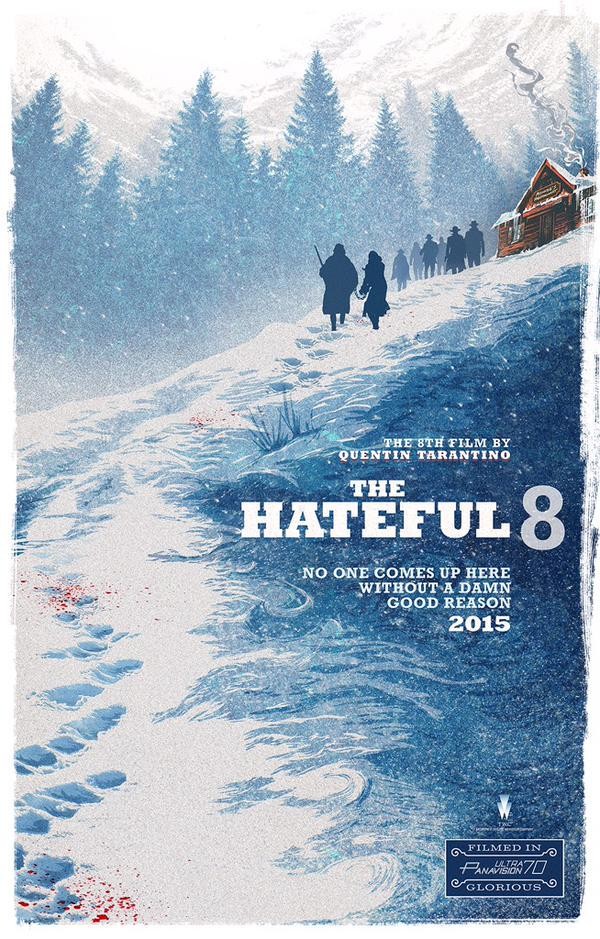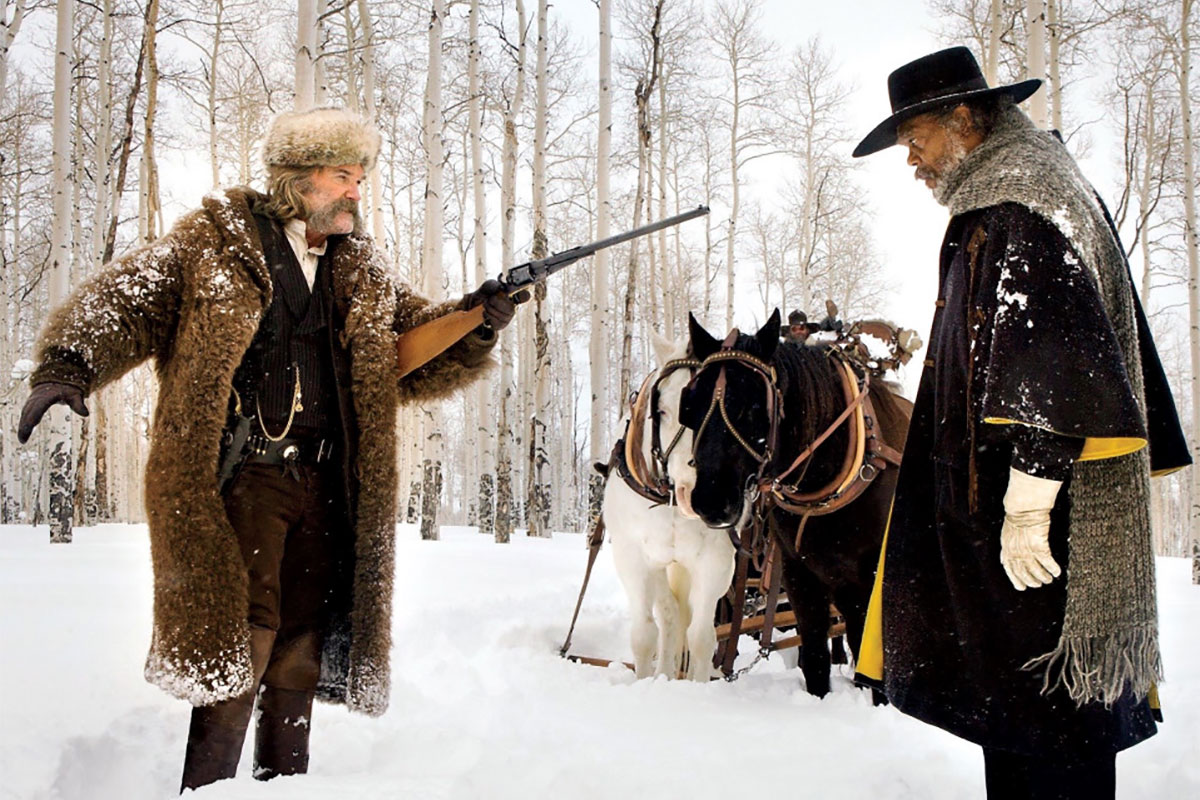What are the differences between “The Hateful Eight” and the leaked script?
Q: What are the differences between the finished film version of The Hateful Eight (the 70mm cut and the shorter 4K cut), released on Christmas day, 2015, and the version of the script leaked online in January 2014?
Fans of Quentin Tarantino and attentive blogosphere followers alike will remember that the site Gawker officially announced the leak of the director’s latest script, The Hateful Eight, in late January 2014. Following this announcement, which some may interpret as a promotion stunt, an enraged (or “very, very depressed” to quote his words) Tarantino threatened not to shoot the film, a decision he later retracted when the film went into production in early 2015, as had been originally planned (“I finished a script, a first draft, and I didn’t mean to shoot it until next winter, a year from now.”). The result is The Hateful Eight (2015).
Having read the leaked script (the first complete draft, dated 12/12/2013), I felt a bit concerned by an overly long exposition—about half the projected running time—indulgent dialogues and a very abrupt, unsatisfactory ending with an awkward twist.

Let us briefly summarize the plot: on a wintry day, in the late 19th century, a stagecoach transporting two bounty hunters, John Ruth (Kurt Russell) and Major Marquis Warren (Samuel L. Jackson), former Southern renegade turned sheriff Chris Mannix (Walton Goggins), and captive murderer Daisy Domergue (Jennifer Jason Leigh) makes a stop on the way to Red Rock—where Domergue is to be tried and hanged—at an isolated coach station known as “Minnie’s haberdashery.” There, none of the regular denizens are to be found, but instead a group of five men await, some of whom might not be who they claim they are.
The first four fifths of the leaked script are almost identical to the finished film. Minor changes involve the following details: The Mexican character Bob (Demian Bichir) was originally a Frenchman (perhaps a role for Jean Dujardin?); Joe Gage (Michael Madsen) is alternately shown eating peanuts and writing “his life story”; a long discussion between Mannix and Warren as we wait to see the effect of a poisoned cup of coffee on Ruth and the coach driver, O.B. (James Parks), has been modified, replaced by a scene in which Domergue plays the guitar (fans may want to find out more about the scene in which said guitar is smashed to smithereens); the brutal demise of Ruth is slightly more elaborate in the film.
The theatrical cut of the film also dispenses with a couple short scenes from the script: one of Mannix and General Smithers (Bruce Dern) drinking together at the bar, one of OB and Warren dropping off the latter’s dead bounties. Also, the way in which Smithers is killed is less spectacular: in the script, he falls into the fireplace and his burning body must be put out by a couple of the characters, creating ideal distraction allowing for the poisoning of the coffee pot.
The script featured five chapters: “Last Stage to Red Rock,” “Son of A Gun,” “Minnie’s,” ‘The Four Passengers” and “Black night, White Hell.” The film features a sixth chapter, located right after the intermission in the 70mm version: “Domergue’s Gotta Secret” (now chapter 4). At that point, the film also features a voice-over by Tarantino, incorporating the “fifteen minutes” of the intermission into the story, and showing Joe Gage and O.B. carrying the dead body of Smithers outside. While there is no indicator in the script’s first draft (on p.87, where it would fall, to be precise) of this intermission/chapter break, Tarantino’s voice was already suggested throughout by non-diegetic descriptions by the writer-director, making us occasionally privy to elements not disclosed through visualized action or dialogues.

The most significant alteration to the script, however, comes later in the game, and concerns the final couple of chapters. The “Four Passengers” chapter (a flashback), revealing the mob’s composition and the fate of Minnie (Dana Gourrier) and her friends, has been moved in the film, in a way that doesn’t seem to make much sense. Indeed, in the script the purpose of the flashback was to reveal the presence of Jody Domergue (Channing Tatum) under the haberdashery’s floorboards. In the film, his presence is simply revealed through a vertical panning shot before the flashback. As a result, the flashback scene seems redundant, and the only element it brings, apart from revealing the cruelty of the Domergue-rescue mob, is the presence of hidden guns under the tables of the haberdashery. In addition, in the script, the bodies of the innocent victims of the mob are dumped down the well, whereas in the script they are merely ordered by Jody to be taken outside and covered up with some snow.
The other and most notable differences in terms of plot concern the last few minutes: the script ends with an episode of Russian roulette between Major Warren and Daisy Domergue (deleted from the film, and replaced here by the threat of making her drink the poisoned coffee), followed by a trademark Tarantino shootout, leaving all but two characters (Chris Mannix and Tim Roth’s Oswaldo Mobray) alive, if fatally wounded, Mannix wrapping himself in a bear skin. Although this latter image is reprised in the film when O.B. wraps himself in the bear skin following his work in the blizzard, most of the above has been deleted or altered. If the finished film’s ending is more elaborate, featuring a coda, it is also more incoherent (Major Warren’s being shot only once from underneath the floorboards by Jody, before the latter’s inexplicable surrender and prompt execution). A protracted scene of negotiation between injured parties ensues, putting Warren’s life in the balance as Domergue tries to bribe Mannix into joining her gang. It is followed by an artificially suspenseful scene, in which Warren runs out of bullets, Mannix passes out, and Domergue proceeds to chopping off the arm of dead Ruth—to which she is still cuffed—in an attempt to reach for a gun. Once this section is over, the film “climaxes” as Mannix and Warren hang Domergue. Finally, Mannix reads an apocryphal letter from Abraham Lincoln to Warren, while both men lay bleeding to death on the bed of Minnie’s haberdashery (a shot strongly reminiscent of the bonding between two dying men memorably featured in 1992’s Reservoir Dogs).
The subplot involving the letter from Lincoln to Warren remains a loose end in the script. It is here tied more neatly: halfway through the film, Warren admits that the letter is a fake, meant to grant him privileges otherwise denied to the African-American man, and so it is re-read and reinterpreted as poetic license at film’s close. Still, somehow it comes off as an artificially stitched afterthought rather than as an organically inscribed element (with the implied meaning, as in The Man Who Shot Liberty Valence (1962), that “the legend creates reality”), which would bestow upon the whole film a greater meaning.
So, to sum up, how much has changed between this first draft and the finished version of the film? The answer is: not enough. The vast majority of the script is identical between script and filmed version. If this definitely supports the theory that Tarantino is very much a film auteur, whose vision is extended faithfully from the paper to the screen, this faithfulness also means that the finished film presents the same flaws as the script, the majority of which the director/writer seems unwilling to improve upon, despite the opportunity that the first draft’s leak offered him.

